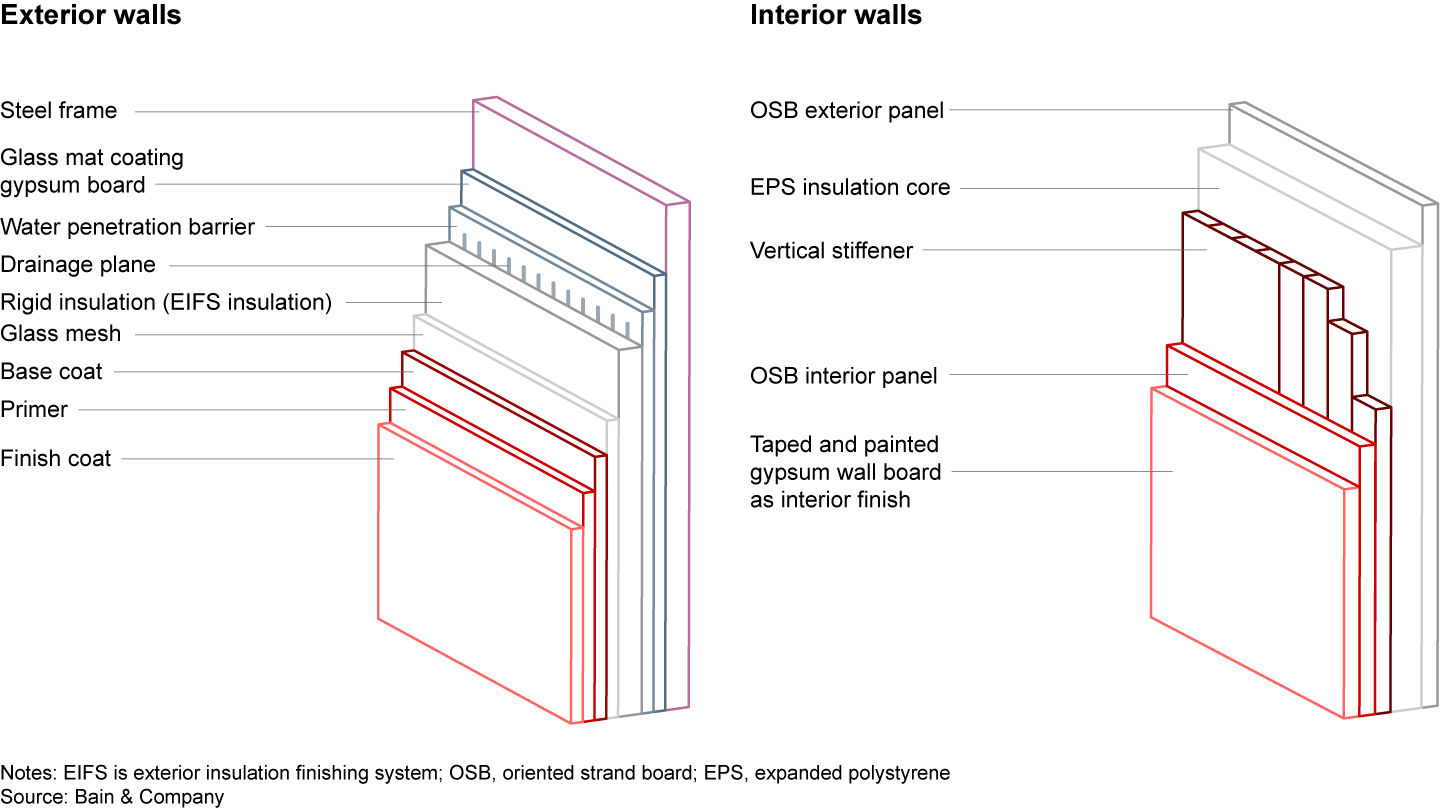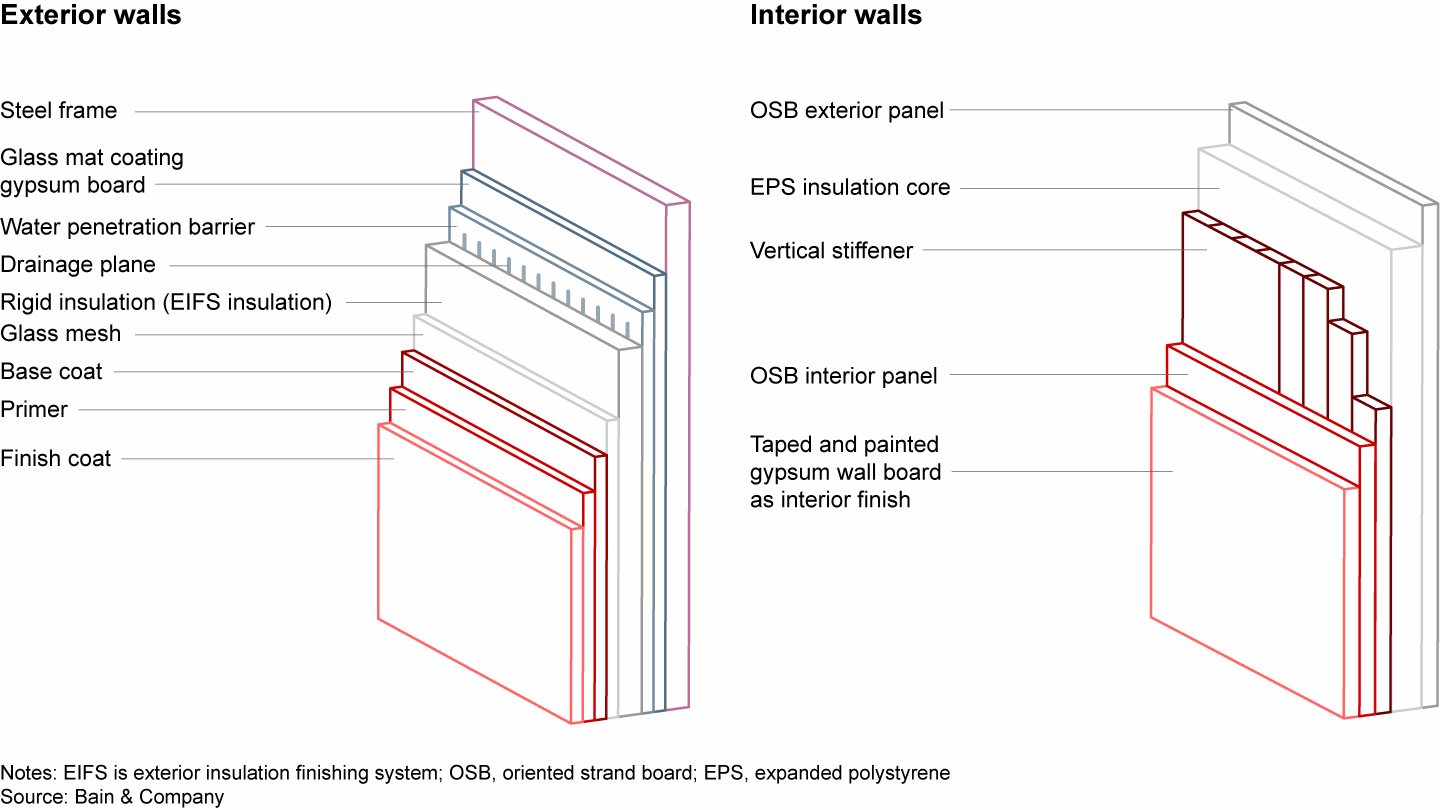Brief

At a Glance
- Off-site modular construction of buildings and homes is efficient and less expensive, significantly saving time as well as material and labor costs.
- But the industry’s fragmented nature among investors, architects, manufacturers, and construction companies has slowed adoption.
- Incentives and regulations can help spur the industry to invest in more off-site construction, as has happened in Sweden and Singapore.
- Designers and manufacturers can prepare for these shifts by investing in digital capabilities, while the construction workforce skills up in assembly techniques.
Although manufacturing industries moved to assembly-line efficiency decades ago, the construction industry is just beginning its transition to more efficient forms of production, as builders begin to adopt techniques for off-site, modular construction—sometimes called industrial design and construction (IDC). Off-site construction is, as the name suggests, the manufacture of building components (including panels, sections, or whole apartments) in a factory; from there, they are transported to a building site for assembly.
The benefits of IDC, especially in large, greenfield projects such as those in the Middle East, are clear. IDC can save as much as 20% in labor and material costs, reduce the need for on-site labor up to 30%, and condense the time for construction by 20% to 50%. Other benefits include design that focuses more on residents’ needs, better quality of construction, and full adherence to design specifications due to the more controlled production environment. Modular construction can also be more sustainable, as efficient processes generate less waste and fewer emissions, and as improved designs use less material and may be more recyclable.
This transition will shift profit pools, benefiting some industry players more than others (see Figure 1). For example, real estate developers could see higher margins due to better executed projects, but they could also see pricing pressure as risk levels drop.
Construction profit pools will shift as off-site construction methods grow and capture higher margins
Despite clear benefits, modular construction accounts for less than 10% of projects in many countries. In some places, market triggers have helped increase the trend. Singapore and Sweden, for example, are forerunners with higher adoption levels, above 30% for new residential buildings. In both countries, regulators and incentives helped kick-start off-site construction. In Singapore, a 2014 rule mandating the use of modular construction on state property helped increase adoption levels from 19% in 2017 to 39% in 2020. In Sweden, a study by Luleå University of Technology found that industrialized housebuilding is more efficient than conventional housebuilding, with 10% greater labor productivity and costs that are about 19% lower. It also allows for construction to continue inside factories, regardless of the weather outside.
Challenges to scale
Market leaders like these are the exception. For the most part, a fragmented landscape of contractors still assembles homes and buildings piece by piece, in unpredictable and unforgiving environments, often with an unreliable labor supply—structural issues that make construction notably unproductive and less attractive to investors.
Other inefficiencies in the construction industry include bespoke project requirements, economic cycles, fluctuating interest rates, and the inherent uncertainty of multi-year projects. The highly fragmented value chain of sub-scale players, varying building codes across geographies, and legacy issues between core stakeholders create disincentives, impede productivity, and slow the adoption of off-site construction.
To encourage adoption, industry players will need to work together and share transitional costs in the interest of generating better returns on investments in the long run. None of the main stakeholders (investors, designers, manufacturers, and builders) have incentives to adopt modular construction on their own. But through shared action, the industry can move in this direction.
The first area requiring cooperation is designing more new buildings for modular, off-site construction, a skill that most architecture and design firms lack. Architects and designers tend to think more about function and aesthetics and less about production techniques. Designers will need to work closely with manufacturers to better understand their production systems, and with construction companies further downstream, to develop expertise in assembly. Strengthening those capabilities and developing a pipeline of designers skilled in prefab architecture will take time and money.
Also, construction remains a mostly local business, but the transition to modular construction will require capabilities that may not be available locally. Builders will need to hire and train workers with these new skills, and this scale-up will require coordination to ensure the labor pool grows at pace with investment and design of IDC buildings.
Finally, construction is highly regulated, and rules differ from one place to another. Modular home builders will need to work closely with regulators in target destinations to understand the requirements, adjust manufacturing processes accordingly, and likely alter standard designs for some projects, based on local needs.
Positioning for success
While different industry segments will need to cooperate to increase adoption, each organization will need to act to ensure its success, depending on its position in the value chain.
- Real estate developers are in a strong position to shape demand for modular construction, more than most other industry players. A long-term focus on higher returns could help many real estate firms weather a period of higher investments, as the industry climbs the experience curve. By deeply cluing into residents’ needs, developers can set construction requirements to guide the design of standardized modules. With their eye on higher replicability, more standardization, and ultimately higher returns on their investments in future buildings, developers could create incentives for designers and architects to adopt innovative, off-site construction methods.
- Architects and designers will have to work at levels of detail more precise than they were used to. In traditional construction, builders can work within parameters to make the pieces of the puzzle come together. But manufactured components offer less wiggle room. Architects often don’t have the experience or technology to raise their designs to the levels that will allow manufacturers to make flawless products. They will need to skill up in digital design, so that they can produce plans for fully engineered products and modules. Building closer relationships with manufacturers will also be vital, as in every other industrial value chain, so that architects can understand the possibilities available for production and collaborate on designs.
- Manufacturers have a rare opportunity to rethink completely how they construct buildings and their components. This is a brief moment when innovations are likely to set new standards—and those who set them will be poised to capture a greater share of the profit pool. To land these opportunities, manufacturers will want to identify the most strategic parts or sections that they should own, while partnering or acquiring makers of other necessary prefabricated modules. This will shift industry boundaries. And in choosing where to focus, manufacturers should determine where they can add most value; some components require more complexity than others. For example, exterior walls are typically more complex than interior walls, offering more potential for adding value (see Figure 2). To encourage the adoption of innovative new standards, manufacturers will need to offer engineering support to designers, architects, and construction firms along with installation guidance.
- Construction companies will expand their business beyond on-site construction, moving increasingly into off-site assembly and even manufacturing. Many builders already use a combination of standardized, prefabricated components, and many already perform some off-site assembly. With the growth of prefabrication, the boundary between the builders and the manufacturers will blur further, and scale will matter more, leading to a consolidation of companies that today may have 50 to 200 employees. Like architects, builders will need to improve their digital design capabilities so they can understand and use plans. A bigger challenge will be reskilling the huge field force, retraining millions of workers on new assembly techniques. Construction jobs will look more like system integration jobs. For some European companies that have already begun to integrate preassembled components, the learning curve for their own and subcontracted workforces lasted a decade or more before expertise reached levels comparable with the new technology.
Exterior walls are more complex and can add more value in prefabrication


Off-site modular construction promises to transform the construction industry, especially for large, greenfield projects where the benefits of standardization and efficiency can be fully realized. If industry players can find ways to share transitional costs, then adoption of modular construction techniques will eventually increase, shifting profit pools. Companies that see the wave coming and can adapt their investment portfolios, design capabilities, or building techniques will be well positioned to make the most of it.